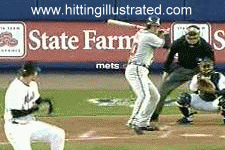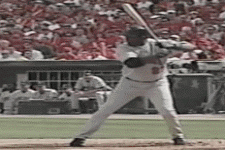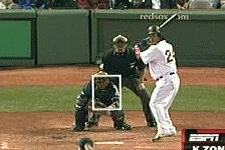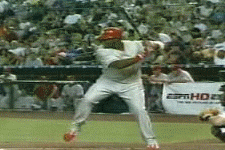EVOLUTION OF THE SWIVEL
HOW DID THEY LEARN TO SWIVEL SINCE IT WASN'T TAUGHT TO THEM
LEAD ARM PULL.....BACK ARM PUSH.....BOTH.....ROTATION.....CONNECTION.....SEPA RATION.....RUNNING START.....WEIGHT SHIFT.....OVERLAP
If you're like me, and have studied video extensively, and have been around the game a long time, an interesting subject always comes up when explaining the high level pattern. How did the high level hitters learn to do what they do? It is clear that most weren't taught the high level pattern. So how did they get to where they are today. And more specifically, I'm going to concentrate on the swivel. The turning of the barrel rearward at "go".
The following is just a theory. It may follow your experience. It may not. Feel free to add your thoughts below. I am by no means offering this as proof of how it developed. This would fall in my "best guess" category.
Let's start with 10-12 year old kids. There appears to be three categories. THE NATURAL, who unknowingly used his body right the first time he picked up a bat, had success and because of that success (and no one coached him out of it) he continued using the high level pattern. We won't concern ourselves with the natural.
The other two categories include the LEAD ARM PULLER, who does just what it says. And the REAR ARM PUSHER, again, who does just what it says. The choice may have to do with their dominant hand, although that doesn't explain a righty thrower who bats left and vice versa.
The Puller is not usually a stong upper body kid. He may have some success at the lower levels but as he goes up the playing ladder, he quickly realizes his bat is dragging. He's too slow.
The Pusher is usually a strong upper body kid. He may also have success at lower levels but soon realizes he pushes himself out of the zone and can't make consistent solid contact. He's too quick.
At that level of play, both kids might just hit the crap out of the ball but suffer from inconsistency. Pitching is not doing it to them. They are doing it to themselves.
So from that starting point, the first need is consistency and the first evolution step is the COMBO. You combine the two. The puller adds the push. The pusher adds the pull. The puller has less pull but substitutes more push. The pusher has less push but substitutes more pull. You end up with the push/pull, somewhere near 50/50 each. The pull, mostly by the lead arm, of both hands forward, combined with the push into contact, by the "hammering motion" (not a swivel) of the top hand, late in the swing. The Combo could also be called the BM.
 We know this is disconnection. Just an arm swing. But the hitter isn't being taxed physically yet and gets by with it.
We know this is disconnection. Just an arm swing. But the hitter isn't being taxed physically yet and gets by with it. This works well for awhile. But as they approach high school, that pitching just gets faster and faster AND they are now changing speeds and breaking pitches off. The hitter has a sudden need for adjustability. Both in handling speeds and handling locations. His need changes from consistency to adjustability. He may or may not consciously know this, but the body says "if I was quicker, I could wait longer, and make better decisions". So, the hitter works on his body mechanics. He works at ROTATION. Using the hips better. Even lifting weights. Trying to increase his body's quickness. The problem is, good hip rotation with disconnection is a band aid. He gets some mileage out of it but he soon learns that won't cut it.
Next he evolves into CONNECTION. Trying to make sure that the new energy found in the new and improved hip rotation reaches the barrel. It's probably found by trial and error. Maybe by emulation. But this step reverses the push/pull step. You can't do both and have success. You can't have connection and disconnection. So, he's quicker, as a result of the new hip rotation, but he has to become a lead arm puller, to maintain connection, in order to deliver the body's energy to the barrel. The push of the push/pull has to go. So....a dilemma. He's quicker. But he's lost his adjustability. He can hit the crap out of a ball that he's "on", but he just can't get "on" often enough. He faces two options. Drag it. Or pull off.
Some where around this time, in his dealing with his problem, he learns SEPARATION of the upper and lower body. Maybe he "gets it" from his throwing. Maybe he just trial and errs long enough and stumbles onto it. But the separation leads to a new level of quickness. The new level of launch quickness helps immensely. But, that pitching, man, it just keeps getting faster and faster. It is REALLY fast now. No matter how quick he is from "go", he just can't get there consistently. And, that adjustability is still an issue.
So, he thinks he needs to get going sooner. He needs a RUNNING START. He needs to start without starting. He needs to start without yet committing. So, through trial and error, he learns to "carry forward". He learns to develop some momentum. This helps a lot. He has already broken inertia and now can swing when he needs to.
But, that pitching. How good can they get?

So, through more trial and error and/or emulation, he learns to WEIGHT SHIFT into 'go'. He already has the momentum of a running start. Now he suddenly energizes the swing by the sudden shift of weight from back to front at "go". A rear leg action. A rear leg push. He comes out of a knee bend. He feels it. He says "this is good". And he learns about that last little bit of stretch he gets as the weight shifts suddenly. This last little bit of stretch happens AS the hands are going rearward. Ala Jeff Kent. The separation has moved from just the upper body versus lower body, to the hands versus the hips. This is his first "feel" of two pivot points. The barrel begins to float rearward as he works on this weight shift. As he works on the two pivot points. As he learns to prepare to make it happen that barrel begins to float.
Suddenly, he "feels" the OVERLAP. He feels how the two pivot points work together to create one move. He feels the benefit of weight back then shift at "go". He learns to "ride the back leg". He learns to maintain the rear hip load AND the posture that is over the rear leg. He learns to create one move that has two directions, (hands going one way, hips going the other) although he couldn't tell you that. He wants to use the hands. And he wants to use the hips. They are going in opposite directions. Because that separation between the hands and the hips occurs, it becomes natural to swivel from that position. He thinks he's doing that old pushing move. The hammering move. But, from that new position, the rear hip pivot point forward of the hands position, that he has learned to achieve, that old pushing move isn't really the old pushing move. It's the swivel. His body has overlapped. It's into a brand new position that allows or creates a need to swivel. It's OK. There is no reason to fight it. Because their is no power outage. That overlap feeling 'feels' powerful. That 'stretch and fire' position 'feels' more than adequate before it happens. Therefore, he doesn't need too much from the hands. Just what they can offer. And, what do they offer. Early batspeed and high adjustability. A rearward arc that allows deep contact. He is happy. Very happy. He has solved ALL of his problems. The dilemma disappears.
He gets called up to the bigs, hits for average with many HR's, the chicks love the long ball, life is wonderful.















Comment